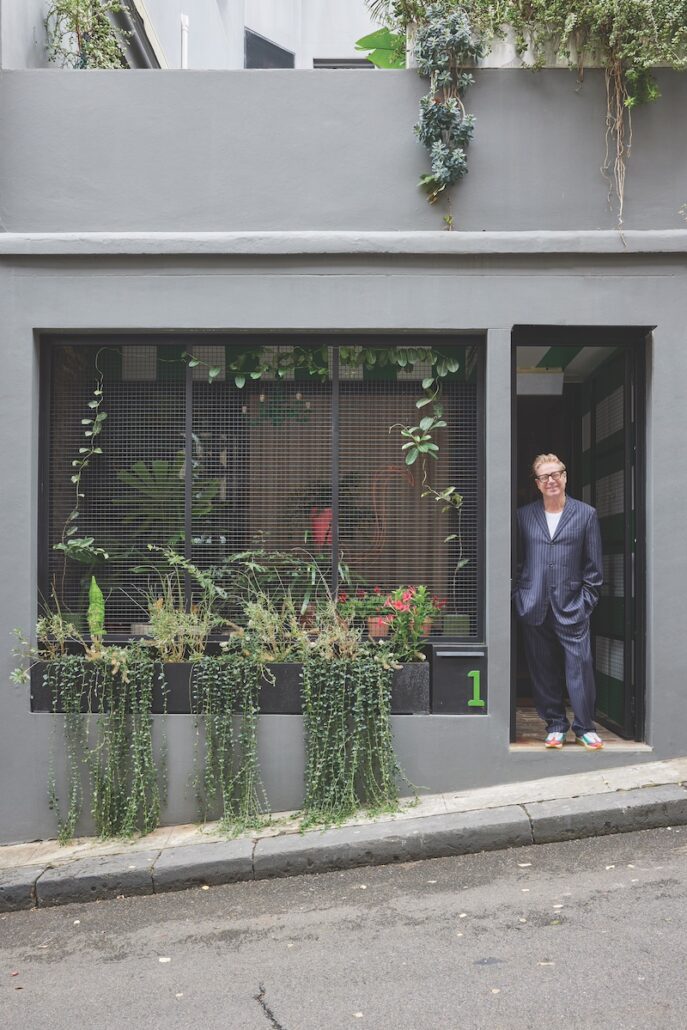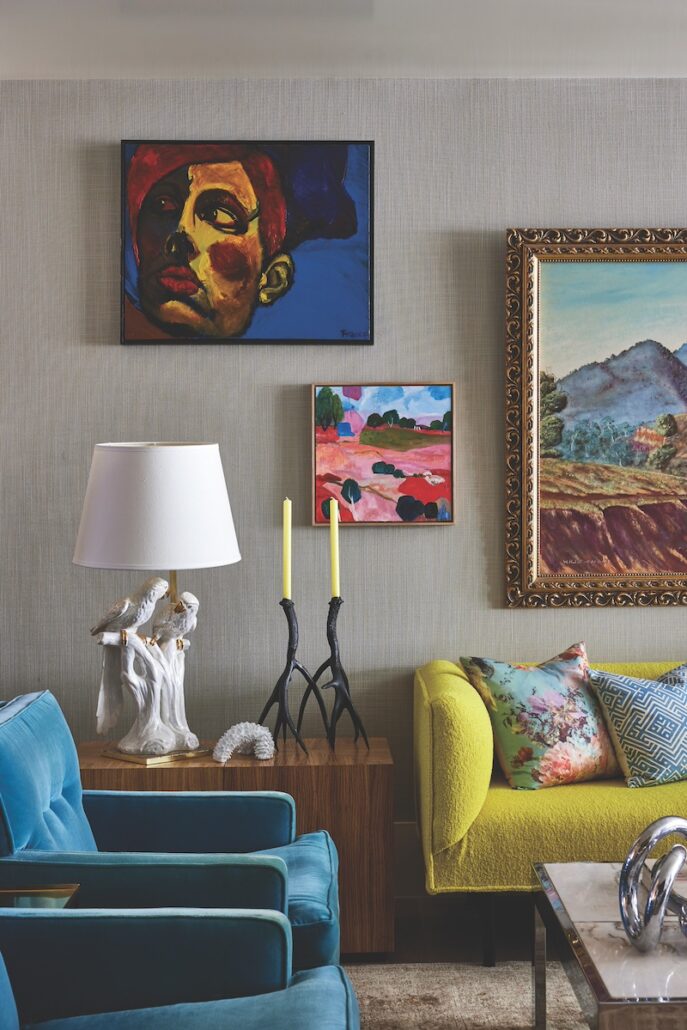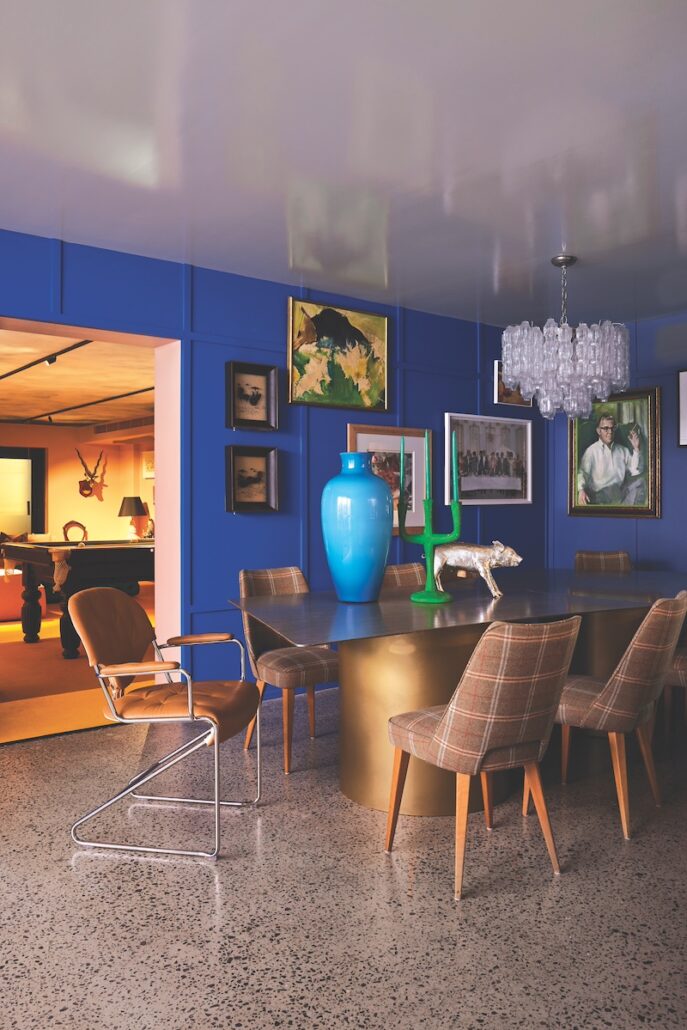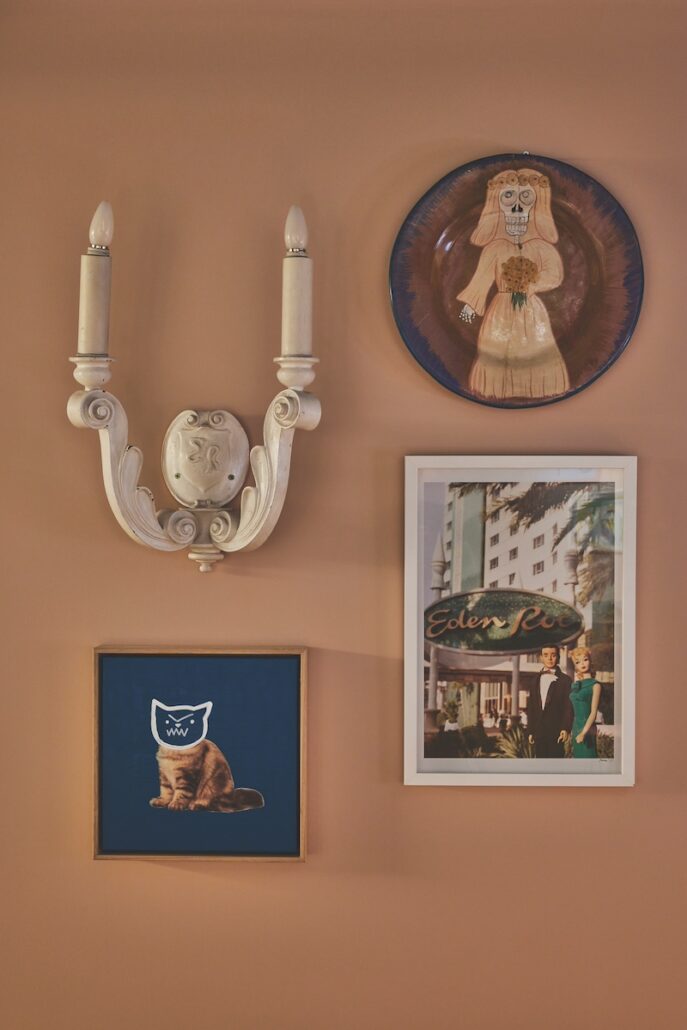In a sloping alleyway, tucked against the grey of a wall in Sydney’s Surry Hills is a home that defies its exterior to tell a thousand tales. It is a place that belongs to interior designer Brett Mickan and his husband Nick English, whose love for entertaining ensured the one-bedroom, 300 square metre home with but a single source of natural light would present the ultimate challenge in creating a delightfully bright place full of whimsey and surprise. “We wanted the design to reference the checkered past and industrial roots of the building,” says Mickan. “Like a great theatre production, the design and material specifications guide you through the journey of the new home. I call it industrial meets Chanel!”
Upon visiting I was regaled with the beginnings of Crawford House’s tale: a man who had lived in the once-grey, dark interior had the property seized from him by the bank. They sealed the doors while he was away, with all his possessions locked within for Mickan and English to find a long while later. This was not without reason. The man, among many things, had been running a secret gambling den in some as yet hidden part of the home, but Mickan assured me it was there, and it was then as I listened keenly that I realised I had fallen into his and English’s glorious trap: the theatre production had started, and I was enchanted.
The living space sprawled out before me in explosions of colour. Furniture hued in vibrant primary colours — several red and blue armchairs sat before a curved, mid-century sofa, once abandoned on a roadside pickup, now reupholstered in mohair, and placed in the presence of another yellow sofa, above which hangs a gold framed landscape painting of Devils Peak, SA as it was in 1932. It’s an artwork which had been gifted to Mickan’s grandparents, and which now sits as a constant reminder of family. Beside it hang many other works in waving arrangement, guiding the eye from one to the next. Two of these are paintings acquired from Sydney’s The Other Art Fair in previous years. Lyndon Keene’s Summer 2, and Joanna Cole’s A Vision Splendid, lending yet more vibrance to the space. On a table in their gaze sits a 1980s Italian cockatoo lamp acquired from a Sydney vintage dealer, excessive in its opulence. “It was perfect amongst our eclectic collection.”
With my mind still upon the secret room, the journey continued. Each part of the home was denoted by function without compromising flair. The wallpapered bar tucked to the side of the living room, the kitchen leading toward Jasmine Poole’s Memento Nori Mate Part 3 — a still-life of a bin chicken enjoying decadent garbage — and the dining room meant to cater to the great many dinner parties the pair love to host. “It might be cocktails for a couple guests, a dinner party for 14 or 100”, they said, but either way the home was designed for peoples’ enjoyment.
From his place atop the marble benchtop in the kitchen, the subject of Martin Claydon McArthur’s Masquerade hangs gazing at the panelled, lapis backdrop of the dining room wall and the many works upon it. Fittingly, among this collection is David Parise’s The last dinner party, because it is Mickan’s belief that all interiors need a little sense of humour. “So, when I found Parise’s work, I had to add it to our collection.”
It is then that he leant against the blue wall, and with a smile pushed it open to reveal the home’s greatest secret: the hidden room. Upon light amber carpet sits the remnant of the life lived by the previous tenant: a pool table, languishing beneath the trompe l’oiel of a blue sky adorned in clouds. Mickan painted the ceiling himself as a wink to the lightless depth of the home, the room filled with paintings, ornate vases, sculptured lamps, and the busts of two animals Mickan celebrates for their beauty. “Purchased from Lydie du Bray Antiques is Jacque, the French Mountain goat, who is approximately 120 years old and was rather musty,” he recounted. “Sanjay, the Indian Blackbuck was also vintage, but his personal hygiene was much better.”
All throughout the home are nods to the pair’s history in the United States. Having lived in Miami for 10 years, pieces such as the Morris Lapidus sconces once found in the original suites of the 1955 Eden Rock Hotel, Kerrie Brown’s are you lonesome tonight — originally designed to be used as wallpaper for a Miami store but which now hangs as a curtain in the pair’s bedroom — and the Kennedy busts in one of the bathrooms all speak to Mickan and English’s American connection and the retro pitch of South Florida.
Every piece of furniture, indeed every artwork, has a story to tell, and none of it is filler. I could have listened to the tales for hours. As for whether there was any inclination that the two would hang their hats and settle into the afterglow of final chapters and interior designs? “We hope not,” they say, Mickan adding, “I believe each project teaches us something new, and we should never stop learning. Both the process and end results of a design project gives me great joy and satisfaction. As long as this continues, so too will the transformations.”
Above: Brett Mickan and Nick English at the bar, with Iksel by Boyac wallpaper behind them.

Brett Mickan standing at the entrance to Crawford House.

In the living room, A Vision Splendid by Joanna Cole hangs beside a gold framed landscape painting, with a vintage cockatoo lamp from Lunatiques.

In the dining room is the custom dining table by Savage Design, piglet sculpture by Harry Allen, blue Murano Vase by Venini.

In the hidden room, counterclockwise from bottom left is Angry Pussy by Kasia Frankowicz, photo by David Parise, clay plate from Arizona by unknown Indigenous artist, and a Morris Lapidus sconce.

